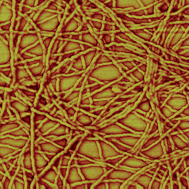Efficient fibre formation for all regioregular poly(3-alkylthiophene)s (P3ATs) with alkyl chain lengths (A) between 3 and 9 carbon atoms has been accomplished in several solvents. It was observed that for the aliphatic and (chlorinated) aromatic hydrocarbon solvents used, the solvent refractive index offers some rationale to predict the feasibility of a solvent for fibre formation. The fibres were separated from remaining non-organised polymer by centrifugation. This enabled the characterisation of the isolated fibres in function of alkyl chain length (A) with TEM, AFM, XRD and UV-Vis spectroscopy. The fibres are 20 ± 5 nm wide and 0.5 to >4 µm long and mainly crystallize in the common type I crystal phase. The order within the fibres was probed with XRD, SAED, and UV-Vis and was found to strongly improve with increasing alkyl chain length in going from P33T to P35T, resulting in a longer conjugation length. For P35T to P39T the improvement in order is only marginal.
Fibres from P37T were found to mainly crystallize in a crystal phase slightly different from type I that we refer to as type I′. This new crystal structure has a lattice constant a that is marginally shorter than that of phase I and a slightly longer lattice constant b of 4.0 Å and thus in XRD can hardly be distinguished from phase I. It is furthermore characterized by a blue-shifted absorption band in UV-Vis spectroscopy. The type I′ fibres were converted into normal type I fibres in the solid state at 70 °C and in solution around 50 °C.

You have access to this article
 Please wait while we load your content...
Something went wrong. Try again?
Please wait while we load your content...
Something went wrong. Try again?


 Please wait while we load your content...
Please wait while we load your content...